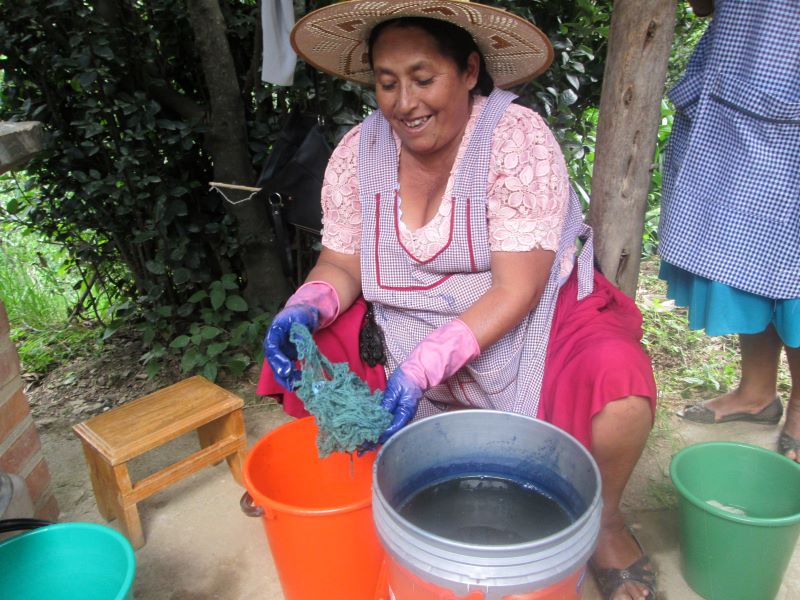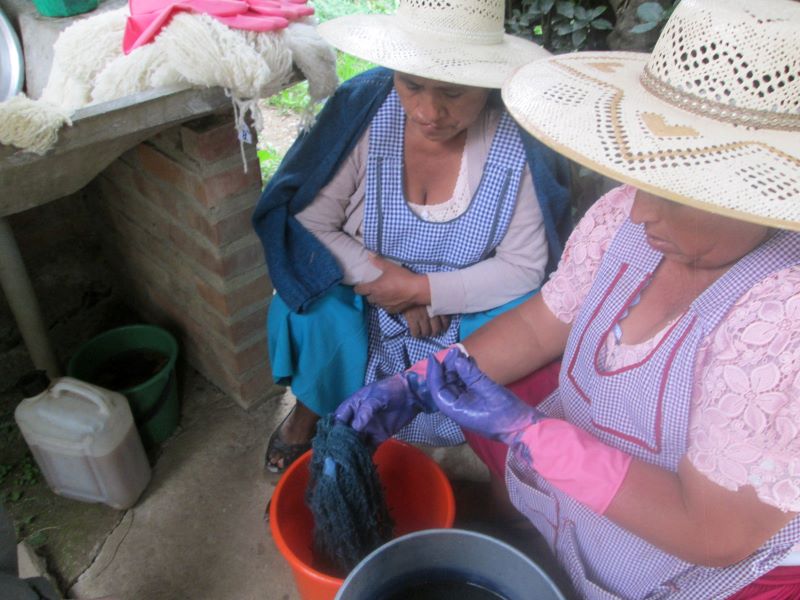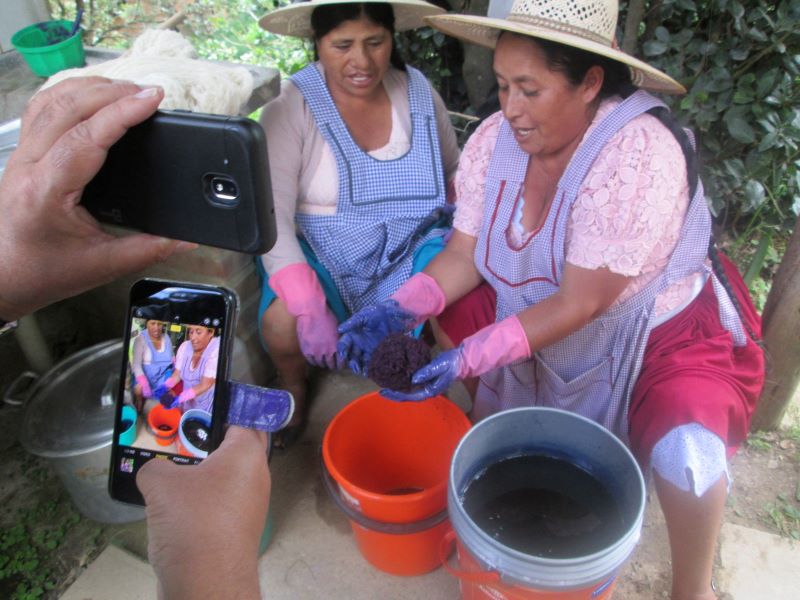
The idea of presenting the magic of indigo to the Bolivian weavers would have remained an idea if not for the subtle but repetitive plea of an old friend. As a fellow textile afficionado he’d spent time in Peru and remains enchanted with the natural dye color palette including indigo that is used by weavers in the communities surrounding Cusco.
The thought of exploring the mysteries of indigo was intimidating. Arrangements were made to do 2 virtual workshops via Zoom with Kelsey Wiskirchen, Executive Director of Weave a Real Peace (WARP) and a 2010 PAZA volunteer. She dyes with indigo for her own art and has taught indigo workshops. She was keen to work with the Bolivian weavers again.

The indigo powder used was Asian Indigofera tinctoria purchased online from MAIWA and carried to Bolivia. MAIWA included an excellent information packet with a variety of recipes with the indigo order. Kelsey researched and experimented and was unperturbed when the recipe she’d selected had to be changed a few days prior to the first workshop because the reducing agent ingredient couldn’t be sourced in Bolivia.

The recipe called for 2 kilos of mature blackening bananas as the reducing agent, 75 grams of indigo, and 75 grams of pickling lime (calcium hydroxide). It took the morning session of the first workshop to figure out a system for reducing the banana mash to sugar water and get set-up for the afternoon session. During the afternoon class the recipe was completed with repeated warnings on how to avoid introducing oxygen into the dye bath. Every movement had to be considered to avoid introducing oxygen by splashing droplets into the dye vat.

The stars aligned for the workshops. Shani, a spinner from London who has supported PAZA’s Spinning Week and her husband, Michael were traveling in Bolivia. It was serendipity that their visit to Independencia coincided with the workshops. Shani held the phone during the Zoom calls, Michael took photos with PAZA´s camera, Dorinda was able to face the call to do the translating, and Doña Maxima and Doña Beatris did the hands-on work. Most of the other Club de Artesanas members were out of town due to the school vacation.
On day #2, the 20-liter bucket of indigo dye was heated up on bricks inside a big dye pot of simmering water before the morning Zoom call. Kelsey had an exhibit of an indigo recipe in a glass jar that showed how much sediment accumulated on the bottom. Due to the length of the skeins that the weavers wind, the method chosen to submerge skeins into the dye vat was to lower it with 2 rubber gloved hands.
Everyone was on the edge of their seat as a skein was brought out of the dye bath and started to oxidize. Each weaver dyed 2 of their own skeins with different results due to the texture of the wool. Doña Beatris´s had more loft and was slower to oxidize. By day´s end all had accepted that her skeins couldn´t be hurried to oxidize between dunks. Doña Maxima overdyed a skein of cochineal pink and it turned out a brilliant purple, only to change to a drab purple after being neutralized in a chicha vinegar rinse. Doña Beatris overdyed a skein of yellow dyed from molle leaves that turned a variegated golden green. The dye day was an empowering experience for Doña Beatris. She started out eyeing the dye vat dubiously and stating she was uncomfortable. At day´s end she said she confident enough to teach the other Club members. A great group dynamic made the workshops such fun.

Doña Maxima and Doña Beatris will be teaching the other Club members. All will get plenty of practice and opportunities to problem solve by dyeing their own plus skeins for the Huancarani weavers. Since only 1 skein can be dyed in a dye vat at a time, it was decided not to teach indigo workshops in Huancarani. The Club members will prepare a 2nd dye bucket when they reconvene so that 2 skeins can be dyed at a time. Kelsey graciously offered to consult if needed as the weavers forge ahead solving the mysteries of indigo dyeing.

Before seeing the dyed skeins, some of the Huancarani weavers said they weren´t interested in a dye that isn´t available locally. They changed their tune once they saw the indigo dyed skeins. Indigo suffruticosa, (Ánil indigo) is native to the Americas including Bolivia. Doña Maxima recognized its Quechua name k´itha tarwi because it´s used as a medicinal.

Thank you, Shani and Michael, for all your help and support that ensured that the workshops were stress-free. Thank you, Lyn, for your continued support of PAZA. Thank you, Rob, for not giving up on indigo being included in the weavings. Kelsey, thank you for providing us such a great learning experience and two extraordinary dye days! Dorinda Dutcher, January 24, 2024




Very exciting